gas type AUDI Q5 2014 Owners Manual
[x] Cancel search | Manufacturer: AUDI, Model Year: 2014, Model line: Q5, Model: AUDI Q5 2014Pages: 316, PDF Size: 78.41 MB
Page 104 of 316
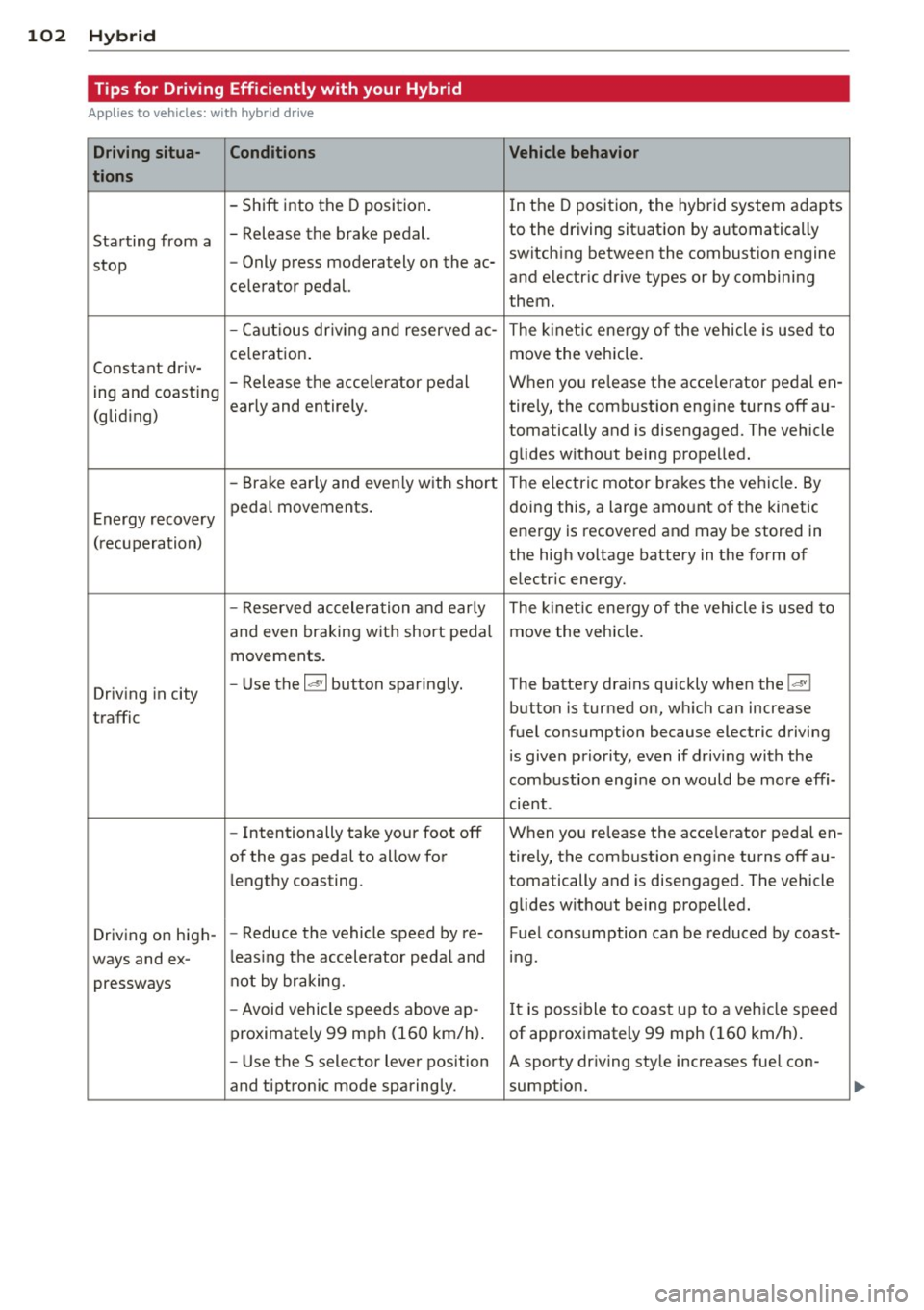
102 Hybrid Tips for Driving Efficiently with your Hybrid
Applies to vehicles: with hybrid drive
Driving situa-
Conditions Vehicle behavior
tions
-Shift into the D position.
In the D position, the hybrid system adapts
Starting from a -
Release the brake pedal. to the driving situation by automatically
stop -
Only press moderately on the ac- switching between the combustion engine
and electric drive types or by combining
celerator pedal.
them.
- Ca utious dr iv ing and reserved ac-
The kinetic energy of the vehicle is used to
ce leration . move the vehicle.
Constant driv-
ing and coasting -
Release the acce lerator pedal When you release the acce lerator pedal en-
early and entirely. ti rely, the combustion engine turns off au-
(gliding)
tomatically and is disengaged. The vehicle
glides without being propelled.
- Brake early and even ly with short The electric motor brakes the vehicle. By
Energy recovery pedal movements.
doing this
, a large amount of the kinetic
energy is recovered and may be stored in
( recuperation)
the high voltage battery in the form of
electric energy.
- Reserved acceleration and early The kinetic energy of the vehicle is used to
and even braking w ith short pedal move the vehicle.
movements .
Driving in city -
Use the
la• I button sparing ly. The battery drains quickly when the laVI
button is turned on, which can increase
traffic
fuel consumption because electric driving
is given priority, even if driving with the
combustion engine on would be more effi-
cient .
- Intentionally take your foot off When you release the acce lerator pedal en-
of the gas pedal to allow for ti rely, the combustion engine turns off au-
lengthy coasting . tomatically and is disengaged. The vehicle
glides without being propelled.
Driv ing on high- -
Reduce the vehicle speed by re-Fuel consumption can be reduced by coast-
ways and ex- l
eas ing the accelerator peda l and mg.
pressways not by braking.
- Avoid vehicle speeds above ajp -
It is possible to coast up to a veh icle speed
proximately 99 mph (160 km/h) . of approximately 99 mph (160 km/h).
- Use the S selector lever position A sporty driving style increases fuel con -
and tiptronic mode sparingly. sumption.
Page 226 of 316
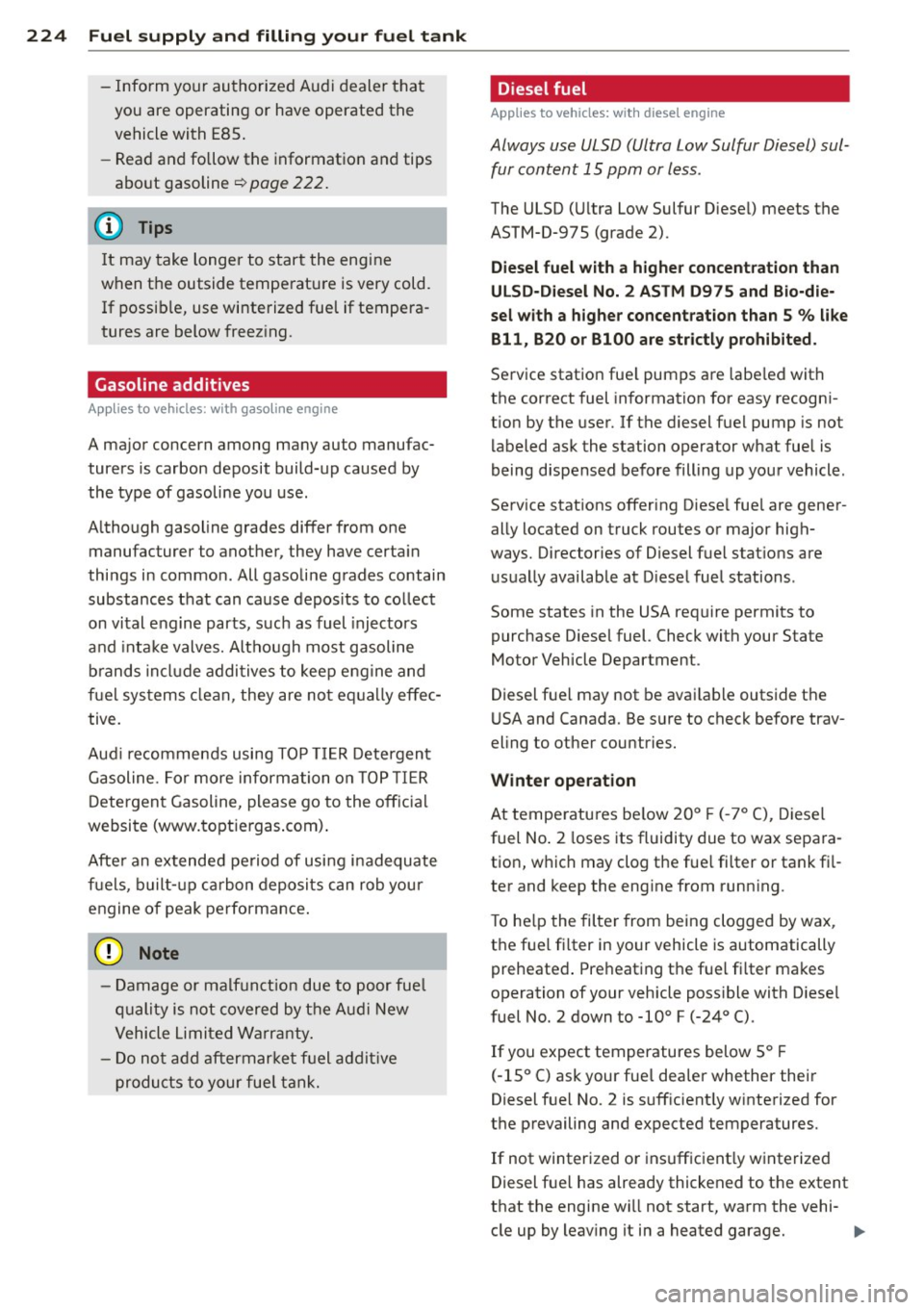
224 Fuel supply and filling your fuel tank
-Inform yo ur au tho riz ed A udi d ealer t hat
you are operating or have operated the
vehicle with E85 .
- Rea d and follow t he informat ion a nd tips
abo ut gasoline
¢ page 222 .
@ Tips
It may take longer to star t the engi ne
w hen t he outside tempe rat ure is very cold.
I f p ossi ble, use wi nterized fue l if tempera
tures are below freez ing.
Gasoline additives
App lies to vehicles: with gasoline engine
A major concern among many auto manufac
turers is carbon deposit build-up caused by
the type of gasoline you use.
A lthough gasoline grades differ from one
manufacturer to another , they have certa in
things in common. All gasoli ne g rades contain
substances that can ca use depos its to co llec t
on vi tal engine parts, suc h as fu el injectors
and inta ke valves . Although most gasoline
b rands include addi tive s to kee p eng ine and
f u e l sys tems clean, they are no t eq ually e ffec
tive.
Au di r eco mmends using TOP TIER Dete rgen t
Ga soline. Fo r more inform ation o n TOP TI ER
D etergen t Gasoline, please go to the off icial
websi te (www. to ptie rgas .com) .
Afte r an ex tended pe riod of usi ng i nadequate
f u els, b uilt-up car bon deposi ts can ro b you r
engine o f peak perform ance .
(D Note
-Damage or malf uncti on due to poor fue l
qu ality i s n ot c overed by the A udi
New
Vehicle Limi ted War ranty .
- Do n ot ad d a fter ma rk e t fu el addit ive
p rodu cts to your fue l tank.
Diesel fuel
Applies to vehicles: wit h diese l eng ine
Always use ULSD (Ultra Low Sulfur Diesel) sul
fur content 15 ppm or less .
The ULSD (Ultra Low Sulfur Diese l) meets the
ASTM-D-97S (grade 2).
Die sel fuel with a higher con cent ration than
ULSD-Diesel No. 2 ASTM D9 75 and Bio-die
sel with a higher concentrat ion than 5
% like
Bl 1, B20 or B100 are strictly prohib ited.
Se rv ice stat ion fue l pum ps a re labe led with
the correct fuel information for easy recogn i
t ion by t he user. If the d iesel fuel pump is not
l abeled ask the station operator what fuel is
being dispensed before filling up you r vehicle.
Se rv ice stat ions offering Diese l fue l are gener
ally located on t ruck routes or major high
ways. Directories of Diesel f uel stat io ns are
u sua lly available at D iese l fuel stations .
Some states in the USA req uire permits to
purchase Diesel fuel. Check with your State
Motor Vehicle Department .
Diesel f uel may not be ava ila bl e outside t he
U SA and Canada. Be s ure to check before trav
eling to other countries.
Winter operation
At tempe ratu res be low 20° F (- 7° C), Diesel
fuel No. 2 loses its fluidity due to wax sepa ra
t ion, w hich may clog the fue l fi lter or tank fi l
ter and keep the eng ine from runn ing .
T o he lp the filte r from bei ng clogged by wax,
t h e f ue l fi lter in yo ur vehicle is automatically
preheate d. Pre heat ing t he f uel fi lter makes
operation of your vehicle poss ible with D iese l
fuel No. 2 down to -10° F (-24° C) .
If you expect temperatures below 5° F
( - 15° C) ask your fue l dea ler whether thei r
Diesel f uel N o. 2 is s uff icient ly w interized for
the prevailing and expected temperatures.
If not winter ized o r ins uff ic ient ly w interized
Diesel f uel has already thickened to t he extent
t h at the engine wi ll not start, warm the vehi -
cle up by leav ing it in a heated garage.
II>
Page 247 of 316
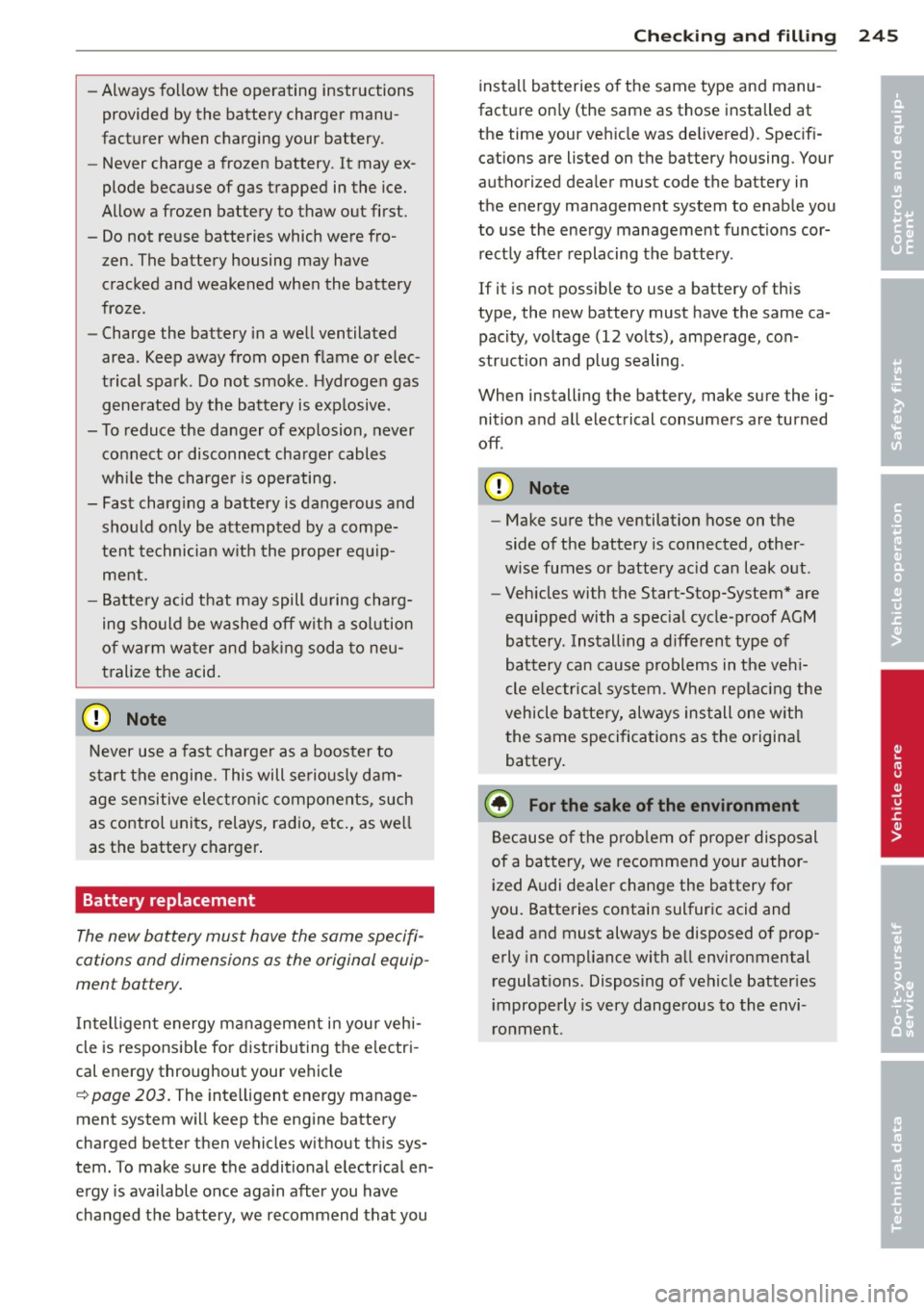
-Always follow the operating instructions
provided by the battery charger manu
facturer when charging your battery.
- Never charge a frozen battery.
It may ex
plode because of gas trapped in the ice.
Allow a frozen battery to thaw out first.
- Do not reuse batteries which were fro
zen. The battery housing may have
cracked and weakened when the battery
froze.
- Charge the battery in a well ventilated
area. Keep away from open flame or elec
trical spark. Do not smoke . Hydrogen gas
generated by the battery is explosive.
- To reduce the danger of explosion, never
connect or disconnect charger cables
while the charger is operating.
- Fast charging a battery is dangerous and
should only be attempted by a compe
tent technician with the proper equip
ment.
- Battery acid that may spill during charg
ing should be washed off with a solution
of warm water and baking soda to neu
tralize the acid.
(D Note
Never use a fast charger as a booster to
start the engine. This will seriously dam
age sensitive electronic components, such
as control units, relays, radio, etc., as well
as the battery charger.
Battery replacement
The new battery must have the same specifi
cations and dimensions as the original equip
ment battery.
Intelligent energy management in your vehi
cle is responsible for distributing the electri
cal energy throughout your vehicle
¢ page 203. The intelligent energy manage
ment system will keep the engine battery
charged better then vehicles without this sys
tem . To make sure the additional electrical en
ergy is available once again after you have
changed the battery, we recommend that you
Checking and filling 245
install batteries of the same type and manu
facture only (the same as those installed at
the time your vehicle was delivered). Specifi cations are listed on the battery housing . Your
authorized dealer must code the battery in
the energy management system to enable you
to use the energy management functions cor
rectly after replacing the battery .
If it is not possible to use a battery of this
type , the new battery must have the same ca
pacity, voltage (12 volts), amperage, con
struction and plug sealing .
When installing the battery, make sure the ig nition and all electrical consumers are turned
off .
(D Note
-Make sure the ventilation hose on the
side of the battery is connected, other
wise fumes or battery acid can leak out .
- Vehicles with the Start-Stop-System* are
equipped with a special cycle-proof AGM
battery. Installing a different type of
battery can cause problems in the vehi
cle electrical system. When replacing the
vehicle battery, always install one with
the same specifications as the original
battery.
@ For the sake of the environment
Because of the problem of proper disposal
of a battery, we recommend your author
ized Audi dealer change the battery for
you. Batteries contain sulfuric acid and
lead and must always be disposed of prop
erly in compliance with all environmental
regulations. Disposing of vehicle batteries
improperly is very dangerous to the envi
ronment. •
•
Page 249 of 316
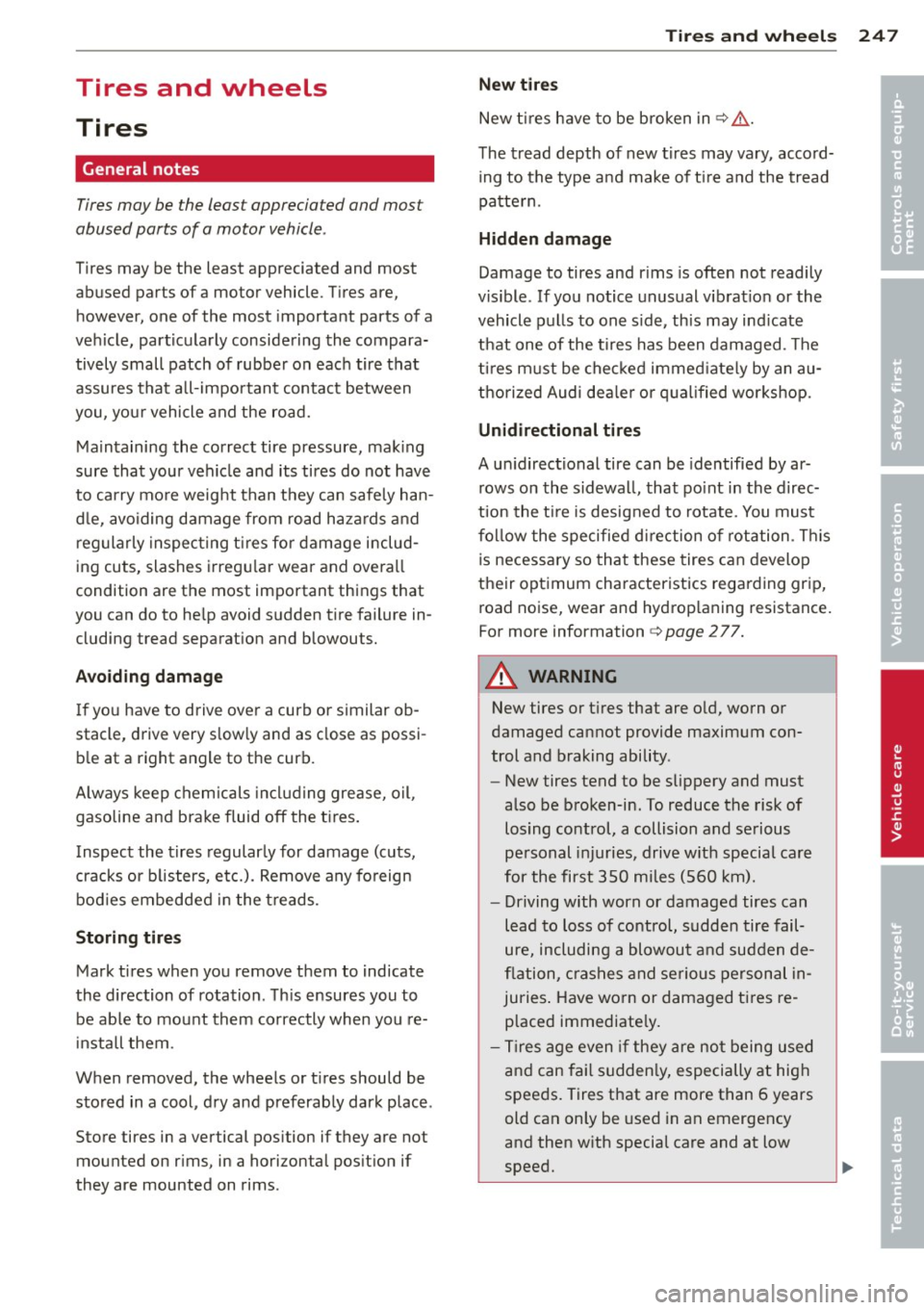
Tires and wheels
Tires
General notes
Tires may be the least appreciated and most
abused parts of a motor vehicle .
Tires may be the least appreciated and most
abused parts of a motor vehicle . Tires are,
however, one of the most important parts of a
vehicle, particularly considering the compara
tively small patch of rubber on each tire that
assures that a ll- important contact between
you, your vehicle and the road.
Maintaining the correct tire pressure, mak ing
sure that your vehicle and its tires do not have
to carry mo re weight than they can safely han
d le, avoiding damage from road hazards and
r eg ularly inspect ing t ires for damage i nclud
ing cuts, slashes irregu la r wear and ove rall
condition are the most important things that
you can do to he lp avoid sudden tire failure in
cluding tread separat ion and blowouts.
A voidin g damage
If you have to d rive over a curb or similar ob
stacle, drive very slow ly and as close as possi
b le at a right angle to the curb.
A lways keep chemicals includ ing grease, o il ,
gasoline and brake fluid off the t ires .
I nspect the t ires regularly for damage (cuts,
cracks or b listers, etc.). Remove any fo reign
bod ies embedde d in the treads.
Storing tires Mark tires when you remove them to indicate
the direction of rotation . T his ensures you to
be ab le to mount them correctly when you re
i nstall them .
When removed, the wheels or t ires should be
sto red in a cool, d ry and preferably dark place .
Store tires in a vertical pos ition if they are not
mounted on rims, in a horizontal pos it ion if
they are mounted on rims .
Tires an d wheel s 24 7
New tires
New ti res have to be broken in¢& .
The tread depth of new t ires may vary, accord
ing to the type a nd make of t ire and the tread
patte rn.
H idden damage
Damage to tires and r ims is ofte n not readily
visible . If you notice unusual v ib rat ion or the
vehicle pulls to one s ide, th is may ind icate
that one of the t ires has been damaged . T he
ti res m ust be chec ked immed iate ly by an au
thorized Audi dea le r or q ua lified wor kshop .
Unidirectional tires
A un idirectional tire can be identified by ar
rows on the sidewa ll, that po int in the direc
tion the t ire is designed to rotate. You mus t
f ol low the specified di rection o f rotation . T his
is necessary so that these tires can develop
their optimum characteristics regarding grip, road noise, wear and hydrop laning resistance.
For more information
¢ page 277.
A WARNING
New tires or t ires that are o ld, worn or
damaged cannot provide maximum con
trol and braking ability .
-
-New tires tend to be slippery and must
also be b roken-in. To reduce the risk of
losing control, a collision and serious
pe rsonal injuries, drive w it h special care
for the first 350 miles (560 km).
- Driving with worn or damaged tires can
lead to loss of control, sudden tire fail
ure, including a blowout and sudden de
fl ation, cras hes and se riou s personal in
juries . Have worn or damaged t ires re
placed immediate ly.
- Ti res age even if they are not being used
and can fai l sudden ly, especially at hig h
speeds. Tires that are more than 6 years
old can only be used in an emergency
and then w ith special care and at low
speed.
•
•
Page 260 of 316
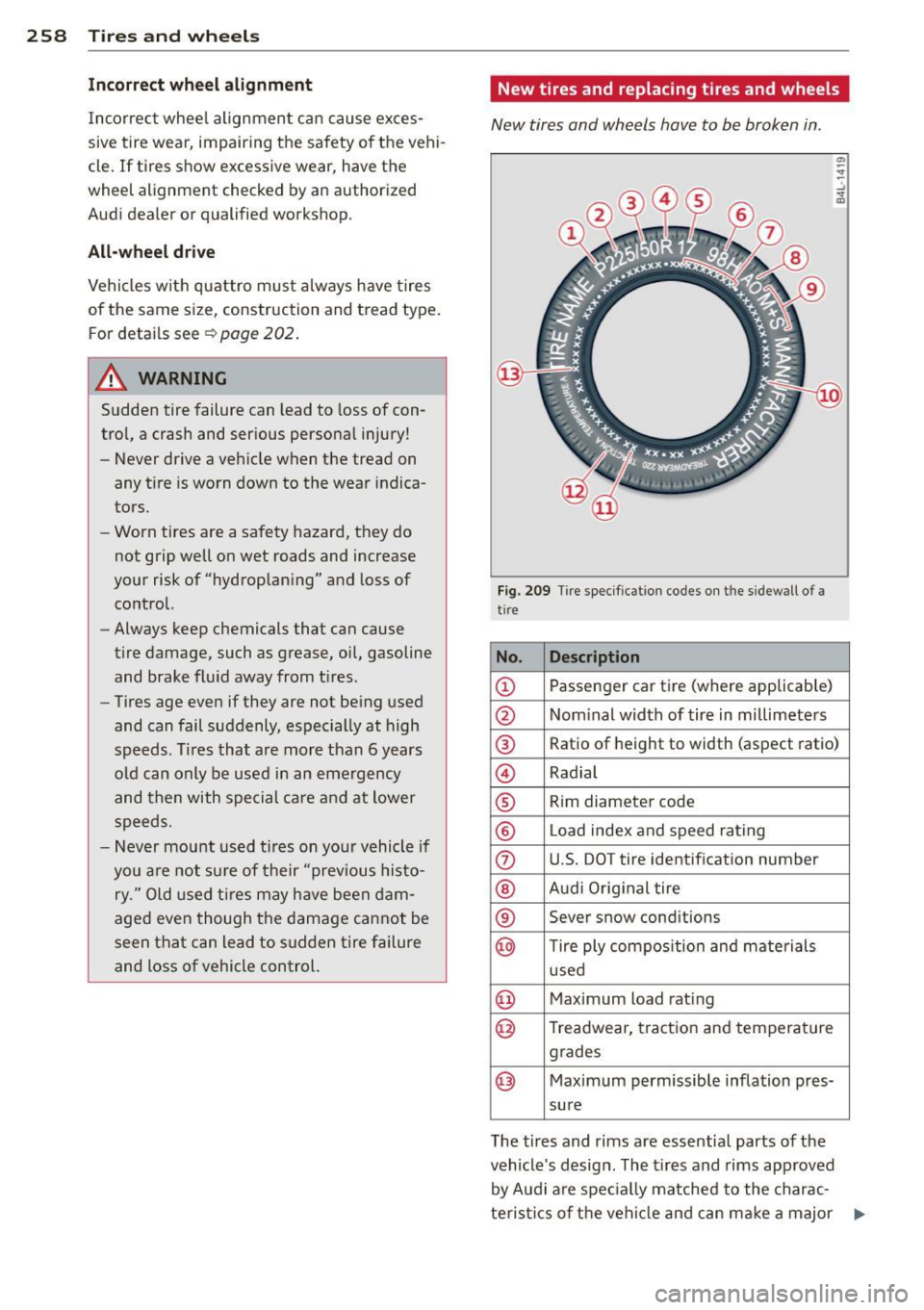
258 Tires and wheels
Incorrect wheel alignment
Incorrect wheel alignment can cause exces
sive tire wear, impairing the safety of the vehi
cle . If tires show excessive wear, have the
wheel alignment checked by an authorized
Audi dealer or qualified workshop .
All-wheel drive
Vehicles with quattro must always have tires
of the same size, construction and tread type.
For details see Qpage 202 .
.&_ WARNING
Sudden tire failure can lead to loss of con
trol, a crash and serious personal injury!
- Never drive a vehicle when the tread on
any tire is worn down to the wear indica
tors.
- Worn tires are a safety hazard, they do
not grip well on wet roads and increase
your risk of"hydroplaning" and loss of
control.
- Always keep chemicals that can cause
tire damage, such as grease, oil, gasoline
and brake fluid away from tires.
- Tires age even if they are not being used
and can fail suddenly, especially at high
speeds. Tires that are more than 6 years
old can only be used in an emergency
and then with special care and at lower
speeds.
- Never mount used tires on your vehicle if
you a re not sure of their "previous histo
ry." Old used tires may have been dam
aged even though the damage cannot be
seen that can lead to sudden tire failure
and loss of vehicle control.
New tires and replacing tires and wheels
New tires and wheels have to be broken in .
Fig. 209 Tir e specificat ion codes on t he s idewall o f a
t ire
No. Description
® Ratio of height to width (aspect ratio)
© Radial
® Rim diameter code
® Load index and speed rating
(J) U.S. DOT tire identification number
® Audi Original tire
® Sever snow conditions
@ Tire ply composition and materials
used
@ Maximum load rating
@ Treadwear, traction and temperature
grades
@ Maximum permissible inflation pres-
sure
The tires and rims are essential parts of the
vehicle's design . The tires and rims approved
by Audi are specially matched to the charac
teristics of the vehicle and can make a major .,..
Page 293 of 316
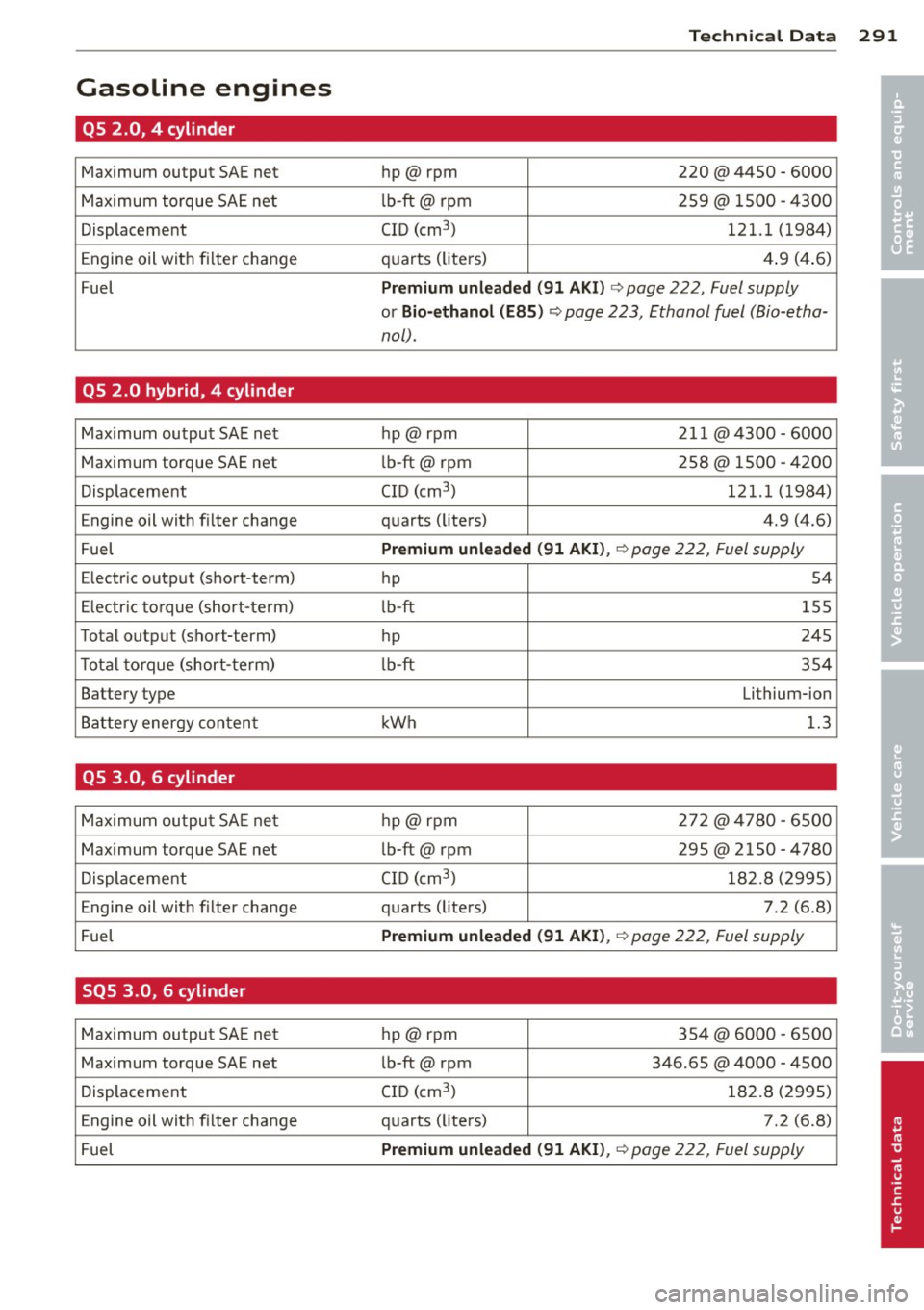
Technical Dat a 291
Gasoline engines
•
QS 2.0, 4 cylinder •
Maximum output SAE net hp@rpm 220 @ 4450 - 6000
Maximum torque SAE net lb-ft@ rpm 259@ 1500 - 4300
Displacement CID (cm
3
) 121.1 (1984)
Engine oil with f ilter change q
uarts (liters) 4.9 (4 .6)
Fuel
Prem ium unleaded (91 AKI) <=> page 222, Fuel supply
or Bio-ethanol (E85) <=> page 223, Ethanol fuel (Bio-etha-
no/).
QS 2 .0 hybrid, 4 cylinder
Max imum output SA E net hp@rpm 211 @4300 -6000
Maximum torque SAE net l
b-ft@ rpm 258@ 1500 -4200
Displacement CID (cm
3
) 121. 1 (1984)
Engine oil with filter change quarts (li ters) 4.9 (4.6)
Fuel
Prem ium unlead ed (91 AKI) , c:> page 222, Fuel supply
Electr ic output (short-term)
hp 54
El ectr ic to rque (shor t-te rm) lb-ft 155
Total output (short-term) hp 245
T ota l torque (short-te rm) lb -ft 354
Battery type Lithium-ion
Batte ry energy con ten t kWh 1.3
QS 3.0, 6 cylinder
Max imum ou tpu t SA E ne t hp@ rpm 272 @4780 - 6 500
Max imum torque SAE net lb-ft@ rpm 295@ 2150 - 4780
Displa cemen t CID (cm
3
) 18 2 .8 (2995)
Engine oil with f ilter change quarts (liters) 7.2 (6.8)
F uel
Premium unleaded (91 AKI) , <=> page 222, Fuel supply
SQS 3.0, 6 cylinder
Max imum ou tpu t SA E ne t hp@rpm 354@ 6000 - 6 500
Max imum torque SAE net lb-ft@ rpm 346.65 @4000 - 4500
Displacement CI
D (cm
3
) 18 2.8 (2995)
Engine oil with filter change quarts (liters) 7
.2 (6 .8)
Fuel
Premium unleaded (91 AKI) , c:> page 222, Fuel supply